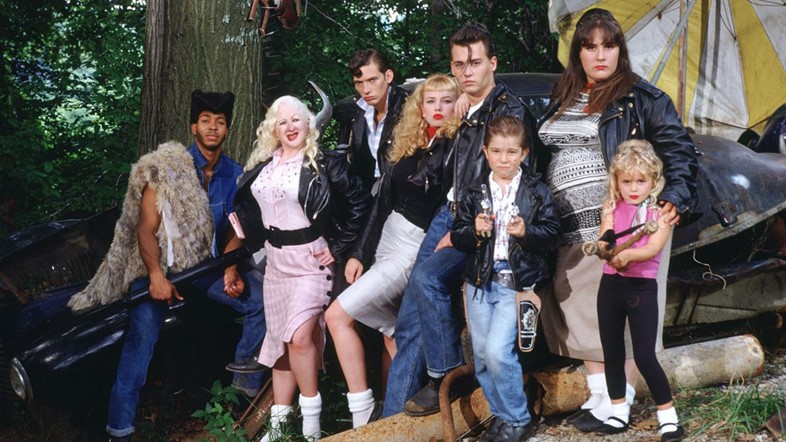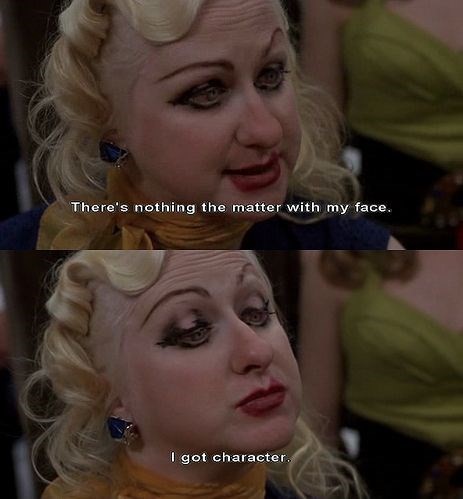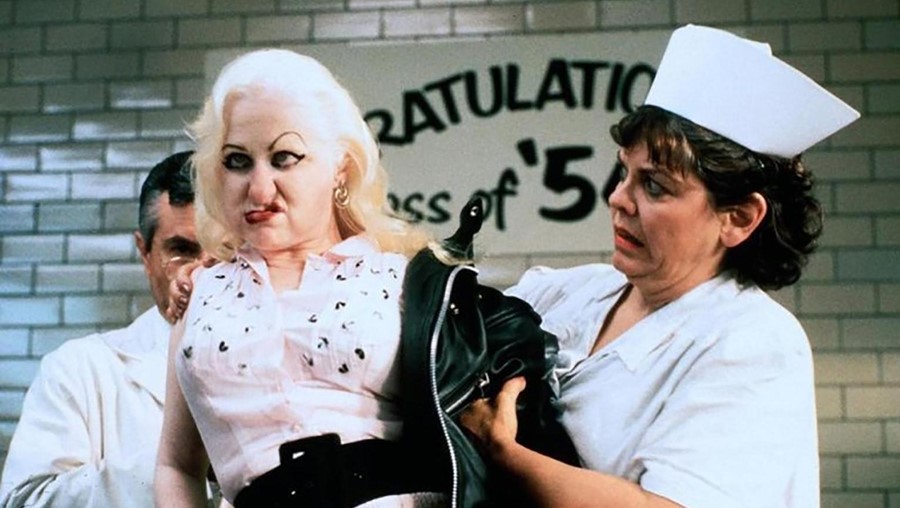Following the recent death of Kim McGuire AKA Hatchet-Face in John Waters’ cult classic Cry-Baby, we examine the considerable impact, both sartorial and cultural, of Waters’ advocation for society’s underdogs
In 1989, filmmaker John Waters, fresh from the success of his musical comedy, Hairspray – which saw the Pope of Trash break through into the mainstream – set about making Cry-Baby, a musical ode to the 1950s and its teenage rebels. Previously accustomed to shooting midnight movies with barely any money, the director was astounded to find himself with a huge budget that could secure him things like “trailers, cranes and giant lights”, as well as an enormous, wonderfully varied cast. Cry-Baby is set in 1950s Baltimore, where teenage high-school students fall firmly into three categories: Squares (rich, preppy, linen-suited and “white” as white can be), Drapes (cool, non-conformist, squeezed into tight trousers or too-small dresses and despised by middle-class society) and Nerds (who don’t get much airtime). The Squares are headed by Baldwin, a smarmy kiss-ass, with a pretty, unsatisfied girlfriend called Allison. The Drapes are led by Wade “Cry-Baby” Walker, played by Johnny Depp in his chiselled prime, an orphaned bad boy, who rides a motorbike, plays the guitar like Elvis, and cries one single teardrop a day.
The film, of course, focuses on the blossoming love story between its devastatingly attractive protagonists, Cry-Baby and Allison, but it is the broad selection of colourful and extraordinary co-characters that makes for such enjoyable viewing – a vital reminder that, regardless of budget, Waters will always be the godfather of slobs and outsiders. “[Where I was raised] everyone was more prejudiced against poor white people than they were against black people,” Waters told Interview magazine of his intentions for the film. “I'd already made a movie [Hairspray] about the unfairness of race that I remembered growing up, and this was a movie about the unfairness of class.”
In the case of Cry-Baby, the most definitive example of Waters’ fondness for the underdog can be found in Mona “Hatchet-Face” Malnorowski, a key member of the Drapes’ inner-circle, played by the late Kim McGuire, who passed away just last month. One look at her facial features, which McGuire skillfully contorts as if made of plasticine, and you can see why she got her nickname; but the Drapes (including her handsome boyfriend, Milton), like Waters, see past her exterior, snarling protectively whenever her physical appearance comes into question. “There’s nothing the matter with my face,” she proclaims in her most memorable line, “I got character.”

The Signature Style
Hatchet-Face, like her fellow Drapettes Wanda (played by the blonde, busty and pointy featured Traci Lords) and Pepper (a chubby and – in the film – pregnant Ricki Lake), favours low-cut dresses (occasionally accompanied by a neck scarf), tight, high-waisted a-line skirts, sleeveless shirts, thick white ankle socks, black pumps and, essentially, a black leather jacket bearing the words ‘Cry-Baby’ on the back. No matter their shape, size or semblance, Drapes wear whatever the hell they want.
When we are first introduced to Hatchet she is standing in line waiting for a school jab; we watch her from behind, swaying her booty from side to side and shaking her peroxide blonde curls. Three Squares go to smack her bum and she turns, revealing a knife, and her distorted, heavily made-up face. Make-up is a key part of Hatchet’s look: she wears vast quantities of kohl smeared around her eyes and concluding in Cleopatra-esque flicks; smudgy lipstick in varying shades of red, with one side of her cupid’s bow comically raised above the other to highlight her lopsided sneer; and pencilled-on brows in dramatic arcs.
As Pepper willingly accentuates her plus-sized curves in her skin-tight apparel, undaunted by society’s judgement, Hatchet-Face slaps on beauty products to draw further attention to her unusual features, rather than conform or conceal them. She stands out like a sore thumb and that’s the way she likes it; after all, even if she tried to disguise herself, people would still judge her. This is pointed out in the scene when she and Milton break into an airfield to steal a helicopter with the aim of busting Cry-Baby out of jail. Hatchet-Face is dressed in her most inconspicuous attire – all-black leggings, off-the-shoulder top and headscarf – albeit with her usual make-up. She stumbles across a cow, grinning at it with her best friendly smile, but upon taking her in the cow gives a startled disapproving moo, and rushes away. Luckily Milton is there to reassure her with a kiss and a, “come on gorgeous” and the two go on their way.

The Modern Manifestation
Hatchet-Face and her and her friends’ embracing of the qualities that make her who she is a major factor in Waters’ enduring cult appeal. From his early collaborations with and championing of off-kilter performers like the inimitable drag queen Divine and the idiosyncratic Mink Stole to his creation of joyfully eccentric characters, Waters has always revelled in what square people revile. In this, the only of his films to have been fought over by movie studios, he certainly toned down his most revolting proclivities, but he also seized the opportunity to celebrate the different in front of a bigger, more conservative audience, not simply because he likes to shock but because that’s where he finds beauty. “They're definitely all beautiful to me,” he told Paper magazine of Cry-Baby’s anti-heroes. “It's all kinds of beauty. To me, nobody's ugly.”
In many ways, Waters paved the way for today’s most interesting and refreshingly unique artists, who feel comfortable enough to go against the grain and be 100% themselves. Lauren Cochrane wrote in The Guardian that elements of Hatchet-Face’s style today manifest themselves in the wardrobe choices of Kim Kardashian, and while that may (arguably) be the case, Kardashian is not who we’re referring to here. Instead, it is through figures like Beth Ditto or Arca that we can appreciate society’s newfound acceptance of the “unconventional”, which owes much to John Waters and to Hatchet-Face herself.
